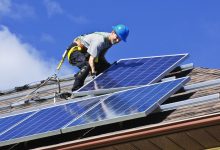The growth of wind and solar continued in Australia during the month of September, and the new additions are clearly playing the key role in reducing emissions from Australia’s main grid – despite some noisy myth–and-mischief-making from the political right.
The monthly National Emissions Audit, produced by energy analyst Hugh Saddler on behalf of The Australia Institute, highlights a couple of key points in the latest month’s survey.
Firstly, is the ongoing growth of wind and solar and their rising share of grid generation. This graph below shows that wind and solar now account for more than 14 per cent of total generation, and will continue to grow as yet more large scale solar farms, which really only made a splash from the middle of 2016, are connected to the grid.
Including hydro, which varies according to season, need and – more recently – the levels of water in dams, the total share of renewable energy remained around 22 per cent. It didn’t grow much in the last month because hydro output fell, offsetting the gains from wind and solar.
But a new graph gives an interesting insight into what this is doing to emissions, and the role that is played by large scale renewables, rooftop solar and other factors such as lower demand and greater efficiency
Emissions from the main grid are now around 40 million tonnes lower than they were just over a decade ago. That’s not the result of less consumption, although that has fallen slightly despite the growth in popultation (and hence a sharp fall in consumption per capita (the blue line).
The biggest contribution has come from the lower grid emissions intensity. That, of course, comes from the addition of cleaner energy resources, which in this case is almost exclusively wind and solar, and because some ageing coal plants have exited as a result, and due to old age.
Rooftop solar also plays a key role, which is often forgotten in the debate about its role in the grid, and the cost of rebates. Those rebates are are a steadily declining one off event, but the rooftop solar will continue generating for at least two decades, in many cases three.
AEMO recently commented too on the impact of rooftop solar on emissions during the day, when it essentially forces out back coal and gas fired generation.













